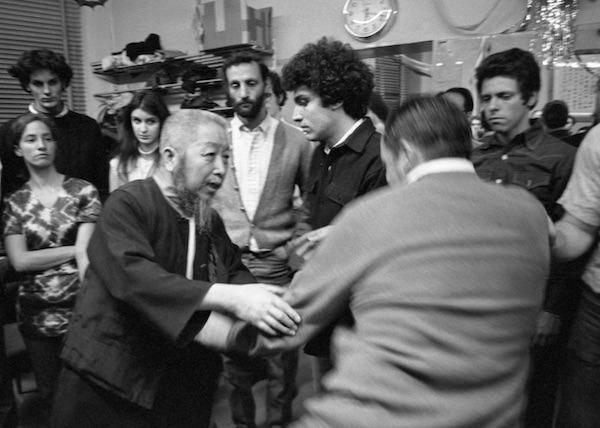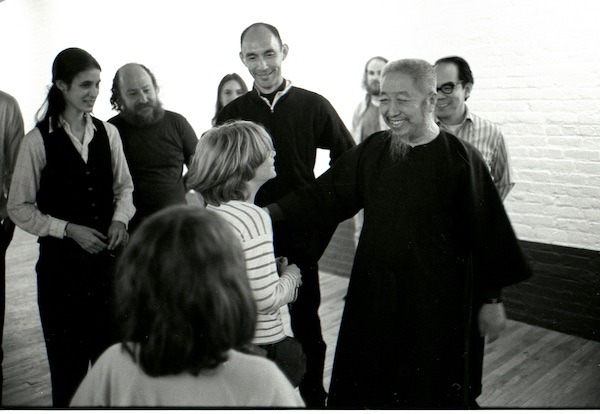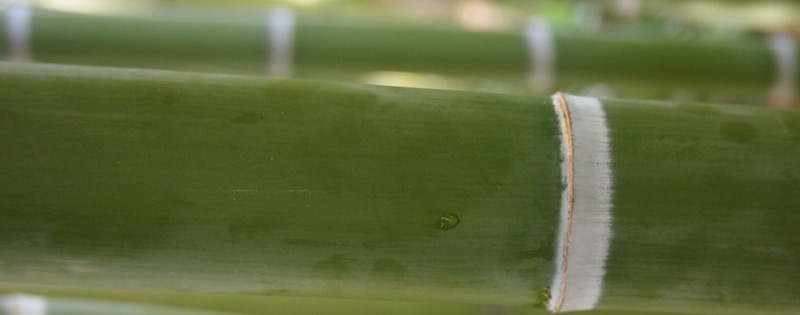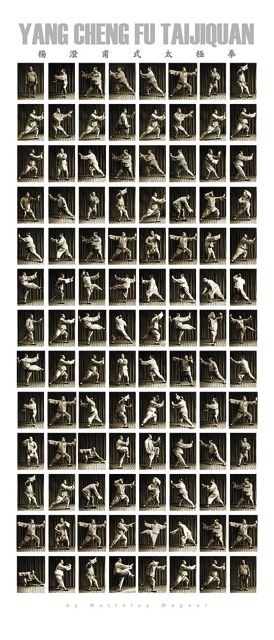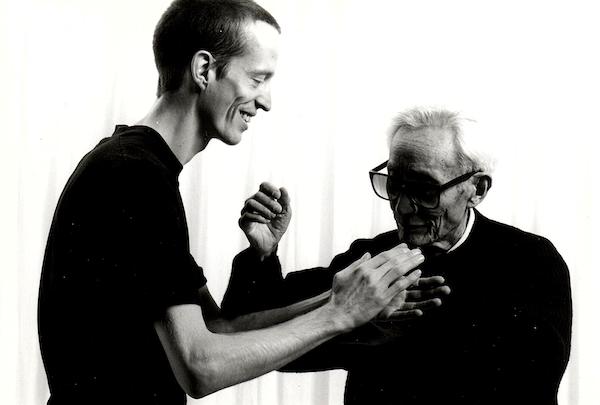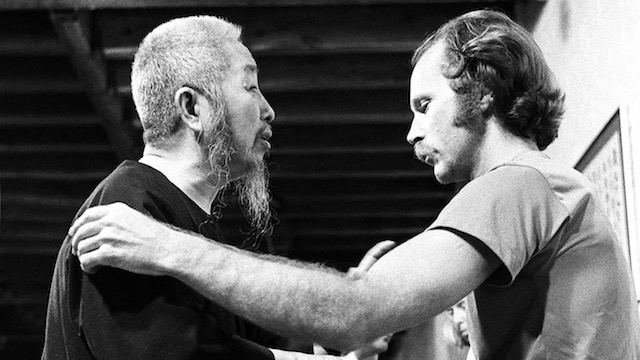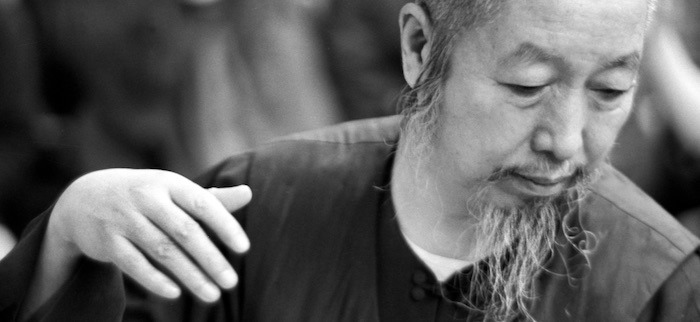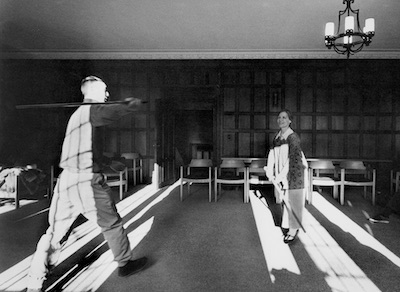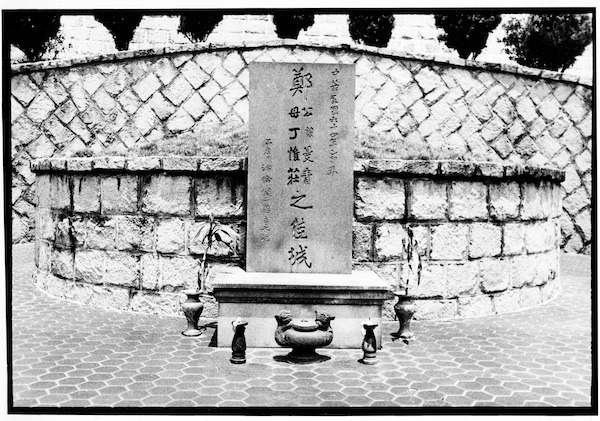When Cheng Man Ching unexpectedly died in 1975, he was buried with a traditional ceremony, which included the writing of a so-called funerary biography. For the benefit of his fellow American students, Tam Gibbs translated Cheng Man Ching’s funerary biography a few years later into American english. This online publication serves to honour Tam’s work and to preserve his effort for future generations of Cheng Man Ching Tai Chi.
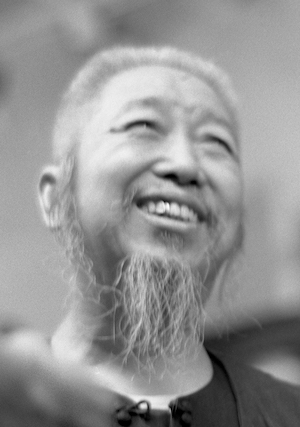
Introductory remarks about the text (by Gabi Kannenberg)
What is a Chinese funerary biography?
The historical use of funerary biographies
Cheng Man Ching – A Confucian ideal
Tam Gibbs’ original translation
Preliminary remark by Tam Gibbs
Cheng Man Ching’s Funerary Biography
Cheng Man Ching: Master of Five Excellences
Professor Cheng’s names
Cheng’s childhood and upbringing: Painting
Cheng’s Youth: Poetry
As a young adult: Teaching Chinese Arts
Cheng in his 30s: Studying the Classics and the Sages
Cheng’s Mid-life: Well-connected in Taiwan
Cheng’s medical education
Cheng’s medical career: Advocating to preserve ways of traditional healing
Cheng’s life as a martial artist
About Cheng’s philosophical work
Cheng’s personality and family
Cheng’s death
Cheng’s literary oeuvre
Introductory remarks about the text (by Gabi Kannenberg)
What is a Chinese funerary biography?
Chinese funerary biographies are a literary genre of its own. Writing such a funerary book was a tradition in imperial China. It marked the significance of a life of an important person. Writing – especially in formal language – was not common and underlined the social status of the deceased as well as the education (when written by the relatives) and/or the wealth (when expertise was bought to write it) of the family.
Furthermore, Chinese funerary books formed part of the remembrance tradition of the family and the social environment. Ancestor’s shrines were common in the old days – and there was a need for stories that could be told about the family’s roots and representatives.
Funerary books can be described as a combination of the traditional speech at the open grave in Western traditions – a ritual for family and friends – and an obituary, that may be published in newspapers or specialist journals – a ritual for the general public or for expert colleagues.
A funerary book creates a perception of the life of the deceased by telling stories about his place in society, his accomplishments, maybe also his shortcomings. – Its main purpose was to shape a picture that will be remembered.
The historical use of funerary biographies
Analysed together with other funerary biographies, funerary books may be used as a historical source concerning the resonating thoughts and values of the time or the shifting of values over time, when different eras are compared.
To reconstruct a person’s life, on the other hand, additional historical sources would be needed. Independent documents confirming places and times, assessment of the probability, analysis of the (hidden) idealism or defamation and the wider historical content would need to be taken into account to find the real life of a person behind the portrayal by the bereaved family and friends.
See also:
https://uwapress.uw.edu/book/9780295746418/chinese-funerary-biographies/
Cheng Man Ching – A Confucian ideal
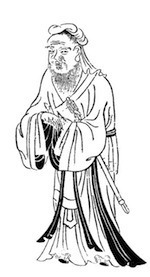
Concerning the life of Cheng Man Ching as a historical human being, one would have to add context to the life his relatives and friends wanted to be remembered.
Concerning Cheng’s biography, it is obvious that some historical developments, which cannot have been unimportant for Cheng Man Ching’s life, were left out. Thus, he is portrayed as a man owning his own fate, learning, creating, teaching, being productive. There is no mention of the reasons that made him act like he did.
Reading the funerary book, Confucian ideals immediately spring to mind. Perhaps it is also due to the Confucian ideal of harmony that the funerary book is context-blind to a point where the Chinese civil war – that Cheng Man Ching’s party lost, causing him to flee his home country – is not even mentioned.
The fact that there is still a traditional funerary book in 1975, points to traditional values still present in the family and the way his life is expressed underlines they cherished Confucian values.
Thus, Cheng Man Ching’s ideal life – as seen by his loved ones – is described by the following text and the significance they rightly believed him to have is established throughout its lines.
Tam Gibbs’ original translation
The text below contains the original translation by Tam Gibbs containing the transliteration that was common in the 70s. We merely eliminated some typing errors and added headings for the reader’s convenience.
Cheng Man Ching’s funerary biography was originally published under the heading: „Cheng Tzu: Master of the Five Excellences – A Life Biography of Cheng Man Ching, by Tam Gibbs“.
The original copyright for web publishing read „© 2004-2018 Sinobarr Productions, Inc. All Rights Reserved.“ – To preserve the accessibility of this text in the digital age, we republish this article with friendly permission of Ken van Sickle.
Preliminary remark by Tam Gibbs
Originally written November 2, 1978, Mr. Gibbs’ translation was done in the presence of Mrs. Cheng as she transliterated the wen yen of Professor Cheng’s funerary book into pai hua so that he could understand it.
NOTE: wen yen is a formal literary type of writing in classical Chinese. It is used to formally underline the importance and dignity of documents. Thus, it is the opposite of pai hua, the colloquial language used in every day life. (GK)
Cheng Man Ching’s Funerary Biography by Tam Gibbs
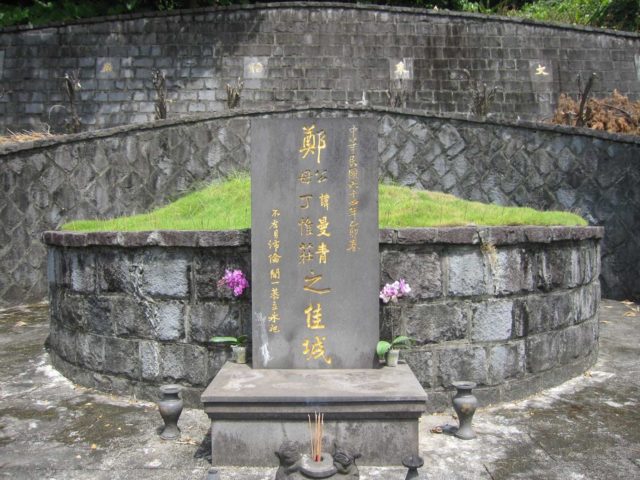
Cheng Man Ching: Master of Five Excellences
In past history, if a scholar mastered a single subject, then others could study it from him. That scholar could then, as a teacher, connect the students with the sages of the past many years ago, a certain Cheng Kuan-wen was acknowledged as being widely knowledgeable and was dubbed san-chueh, having achieved excellence in three fields (poetry, calligraphy, and painting. Down the ages it has been lamented that there have been so few like him.
Now, Professor Cheng excelled in five fields: poetry, painting, calligraphy, and t’ai-chi ch’uan (a martial art), and medicine. He was famous the world over for these attainments. He also studied deeply the teachings of former sages, and was such a prolific writer that he did not realize old age was creeping upon him. Professor Cheng surpassed the accomplishments of Cheng Kuan-wen. People who believe him to be the most outstanding individual in Chinese cultural history in this century (literally, since the founding of the Republic of China, 1911) are not exaggerating.
Professor Cheng’s names
Professor Cheng’s childhood name was Yueh. His widow told me that when he was 40 year’s old he used the name Man-ch’ing. He was born in Chekiang Province in the fu of Yung Chia (present day Wenchou), ten years before the founding of the Republic of China (i.e. born 1901- Ch’ing Dynasty Kuang-hsu 28th year), on the 25th day of the 6 th moon (Chinese calendar), on the day following the birthday of the lotus flower. Therefore he took “style” name of “Father of the Lotus” (actually father of the seeds, because the flower was born before Professor Cheng, and Professor was born before the seeds).
One of his pen names was “Hermit of the Jade Well.” After he passed the age of 50, he grew a beard and took the name “Man-jan” or “Whiskers Man”. Even after the age of 60 he often studied untiringly through the night, so he also had the name of “Host of the Tower of Long Evening.” There are other reasons too, for this name.*1
(*1 Professor Cheng adopted this pen name in New York where he lived in an apartment in a New York building -he could see the New York skyscrapers tower into the long evenings. He also called himself “The Old Child Who Never Tires of Learning.”)
Cheng’s childhood and upbringing: Painting
Professor Cheng’s father died when he was a child. His mother, whose maiden name was Chang, taught him poetry and calligraphy. He could memorize at a glance.
At the age of 9, a brick fell from a damaged wall, hitting him in the head. Blood covered his body. He was in a coma for two days and two nights. A teacher of the martial arts named Chou Min-ch’i went to the mountains and gathered herbs which cured the boy. However, he was like a vegetable. He lost his memory.
At age 10 he studied painting with Professor Wang Hsiang-ch’an. All he could do was stand by the teacher and grind ink. All he did was recuperate and look at the paintings.
Three years later his health improved a little. In the evenings he would take the left over paper wrappers from his maternal grandmothers medicine and paint a flower, a leaf, an insect, or a bird (the wrappers were very small). At age 14, his teachers wife asked him to paint a wisteria and what he painted had the flavor of Yu’n Nan-t’ien and Huai Hsing-lo, both famous painters. His teacher was pleased and dubbed Professor Cheng’s studio the Wisteria Flower Studio. His teacher told him how much he should charge per painting (this is a tradition in Chinese painting -when a painter comes of age” his painting master gives the student a name for his studio and sets a basic price for the students paintings).
From that time on, Professor Cheng supported his family by means of his paintings. With the extra money he bought the paintings of Jen Pai-nien, Chao Hui-shu, and other famous painters. Also he received help and advice from his aunt Chang Kuang, who was also known as Hung-wei Lao-jen, in the method of painting outlines. Sometimes he would play with his cousin who would blindfold Professor Cheng. Professor Cheng who would then try to paint an entire bamboo several feet long in the “outline” method. He could do it without making a mistake at the joints, twigs, or where the leaves crossed.
Cheng’s Youth: Poetry
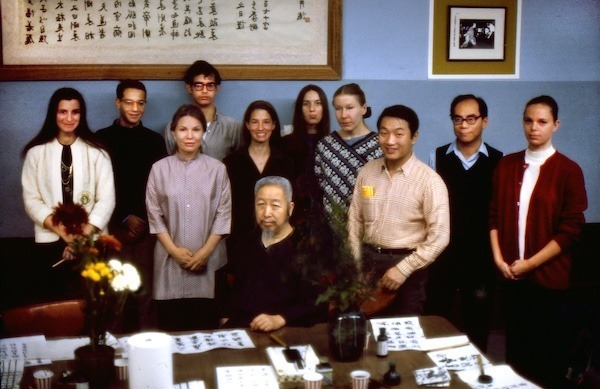
The following year, an aged poet named Lu T’ung-pei gave him an introduction to Shen Mei-so, Ma Yi-fu, Ching Tzu-yuan, Lo Hsing-hu, Wang Chien-lo, and others of the city of Hangchou. He sent Professor Cheng there to associate with them and discuss painting, poetry, and calligraphy.
At age 18 he went to Peking along with Lo Fu-k’an and LoYing-kung (brothers). They published poems in the newspapers in the “ch’ang-ho” style (a style of poetry where two people make up an extended poem – the first person writes a line and the second person writes a line which rhymes with the first, although the content or line of thought is not the same). The three poets became fast friends. (It should be noted that the brothers Lo were quite old. In Peking they were quite famous for their cultural attainments). Because of this association, Professor Cheng received an invitation from Yu-wen University to teach poetry.
Thus he came to know Cheng Su-k’an, Chen Shih-tseng, Ling Chih-chih, Yao Man-fei, Wang Meng-pai -all famous men of culture. After 6 years of close association with these men, Professor Cheng’s painting developed along the lines of Pai-yang, Ch’ing-tung, and at last approached the quality of Pa-ta. Professor Cheng’s calligraphy followed the path of Yi-shao, Pei-hai, and proceeded towards the ancients of Han and Wei dynasties. His poetry progressed from Ch’ing to Sung to T’ang dynasties. Thus he continually improved and evolved.
As a young adult: Teaching Chinese Arts
At the age of 24, Ts’ai Chueh-ming (Ts’ai Yuan-pei, founder of Peking University) gave Professor Cheng an introduction to teach at the National Chi-nan University. Wu Ch’ang-shih and Chu Ku-Wei had a great deal of respect for Professor Cheng. So the Shanghai School of Fine arts invited him to be director of the department of Chinese painting. At that time Chang Shan-tzu and Chang Ta-ch’ien (brothers) and Ma Meng-jung and Ma Kung-yu (also brothers) were invited by Professor Cheng to teach painting in the department to firm up the foundation of the students.
At the age of 29, with Huan Ping-hung and others, Professor Cheng founded the College of Chinese Culture and Art. Professor Cheng took the post of vice-president. He stressed that poetry and literature, calligraphy and painting, and seal carving (an art in itself), all were equally important.
Cheng in his 30s: Studying the Classics and the Sages
At the age of 30, Professor Cheng retired from teaching. He traveled to Yang-hu in Chiangsu province and studied with master teacher of the classics Ch’ien Ming-shan. He put his heart and soul into studying the classics and the sages, and for 3 years his feet never left the school’s door. He took no summer vacations or vacations of any kind.
Professor Cheng once commented to me, “Tam, during that time of study of Master Ming-shan, I never slept. I burned the midnight oil for three years and no one ever saw me except my teacher, and that was only when I handed in an essay to him.” Pursuing this road to its furthest reaches, having inspected the minutest points, he forgot all else and entered the Tao of knowledge.
As a result, his poetry became pure, clear, robust and real -without frills or artificiality. His calligraphy was full, unified, even, and solid. The strength of his brush stroke seemed to penetrate through the paper. His painting was simple yet refined, and at the same time solid. The ink seemed to maintain its freshness and even the water seemed to have body. The composition of his paintings was marvelous, although it looked plain. He influenced calligraphers and painters, whose works were solid, weighty, and plain. He wanted to eliminate the modern trend toward the superficially pretty and frivolous.
Cheng’s Mid-life: Well-connected in Taiwan
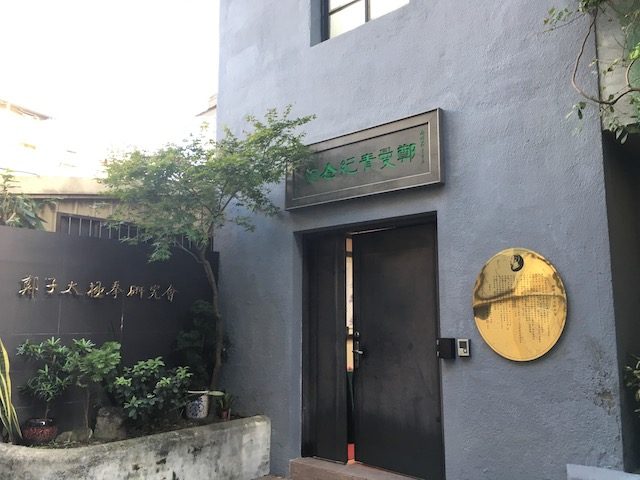
After coming to Taiwan (he was 40-50 years old) he and such luminaries as Yu You-jen, Ch’en Han-kuan, Chang Chao-ch’in, Ma Shao-wen, Chang Ching-wei, and others, formed a poetry society. With Ma-Shou-hua, Tao Yun-lo, Ch’en Feng, Chang Ku-nien, Liu Yen-t’ao, and Kao Yi-hung, he formed the “Seven Friends of Painting and Calligraphy Group.” He also was among those who began the Republic of China Fine Arts Society. He was elected an officer of the Society and also served as head of the Chinese painting section.
Professor Cheng was invited to participate in organizing a National Painting and Calligraphy Exhibition and to be one of the judges for their events. He was also invited to a lifetime professorship at the College of Chinese Culture to teach on the subjects of poetry, painting, and calligraphy in the fine arts department of the graduate school. He was also named Director of Fine Arts of the American branch of the Republic of China Cultural Renaissance Movement.
During a span of 25 years he had many one man shows both at home and abroad. One was at the National Cernuschi Gallery* in Paris and at the World’s Fair in New York in 1964 Western artists were greatly impressed and expressed their respect. People complimented him as being a master of ink painting. His fame was fully warranted, not just circumstantial.
*NOTE: The „Musée Cernuschi“ was founded in 1898. It developed out of a private collection donated to the city of Paris by its owner. Today, the museum describes itself as ranking among the five most notable collections in Europe and as being the second in Paris. (GK)
https://en.wikipedia.org/wiki/Musée_Cernuschi
Cheng’s medical education
Professor Cheng’s mother was skilled at differentiating medicinal herbs. When Professor Cheng was young, he was often ill. He often accompanied his mother to pick herbs; thus sprouted in him the desire to use medical knowledge and herbs to help the world.
At age 25, Professor Cheng came to know Sung You-an of Anhui province, whose family had been famous for nine generations as practitioners of medicine.
Professor Cheng greatly respected him and became his disciple. Actually Dr. Sung sought out Professor Cheng. According to Mrs. Cheng, the story goes as follows. Dr Sung was in his seventies and had long since retired. His four sons were all famous doctors, but their father was still looking for someone to teach all the mysteries of his medical knowledge to. Evidently, his sons were not fully capable of grasping all that Dr. Sung knew. Dr. Sung was visiting an old friend in Shanghai and happened across a prescription Professor Cheng had written. Professor Cheng was not a professional doctor at the time, but he would write prescriptions for friends. Upon reading the prescription, Dr. Sung was greatly impressed and told his friend that he would like to meet the author of it. No doubt he was an old and experienced doctor of medicine, and Dr. Sung would like the opportunity to discuss medicine with such a man. It would be nice, he told his friend, for two greybeards of medicine to compare theories.
Dr. Sung’s friend chuckled and said that the author of that prescription was not exactly a greybeard. in fact, he was a young Professor. When Dr. Sung heard that Professor Cheng was a young man, he felt -a surge of hope that this was the student to whom he could pass on his knowledge. But when he learned that the young man was already a Professor, his hope ebbed. How could he presume to ask a man already established as a Professor to become a student again?
Dr. Sung returned to Ahui disappointed. From time to time he would make the long journey to visit his old friend, hoping that somehow he could meet Professor Cheng. And his friend, in the meantime, prevailed upon Professor Cheng to go study with old Dr. Sung. But Professor Cheng was so busy teaching classes and administrating his college that he had no free time except for holidays and summer vacation. Nevertheless, Dr. Sung’s friend persisted.
Finally, Professor Cheng decided to go visit old Dr. Sung. He had learned that the venerable doctor dearly loved to eat preserved leg of dog this delicacy was a specialty of Professor Cheng’s home province of Chekiang. However, preserved dog’s legs were extremely difficult to obtain, because they were used in the process of preserving hams. For every 100 hams, one dog’s leg was used to impart a special flavor to the hams. Usually the dog’s legs were set aside for the exclusive use of master chefs.
Nevertheless, Professor Cheng managed to obtain one, and along with three other gifts, such as finely woven cloth, white fungus, etc., set off to visit old Dr. Sung in Anhui province. Dr. Sung was happy indeed to see him, but refused the presents – except for the dog’s leg.
Professor Cheng wanted to kow tow and go through the formal ceremony of becoming a student. But Dr. Sung declared it was not necessary. Let them, he suggested, abide by the tradition of “instruction without regard to difference in age” (wang-nien chih chiao). But Professor Cheng insisted on the traditional student-teacher relationship, for It was well known that only a student who had gone through the formal ceremony would be taught openly and freely all the secrets the master knew.
The two men were at loggerheads: Professor Cheng would not study without kow tow, and Dr. Sung was not willing to have Professor Cheng kneel before him. Would this be the end of it? Would they part because of their mutual insistence?
Then Dr. Sung found a way to satisfy both parties. He said to Professor Cheng, “Very well then, kow tow to my ancestors.” He then indicated the altar which held the spirit tablets of his ancestors and Professor Cheng performed the ceremony there.
Thereupon old Dr. Sung came out of retirement. He hung out the sign indicating he was once again practicing medicine. This enabled Professor Cheng to experience firsthand how the old doctor treated his patients from start to finish. When Dr. Sung was not treating patients, he instructed Professor Cheng regarding which books to read and what to look for in them.
Professor Cheng’s intelligence was above normal, and morning and night he listened to his teacher talk about the Tao of medicine. Thus he came to thoroughly understand the wonderful mysteries of the prescriptions of the great doctors of Tang, Sung, Yuan, Ming, and Ching dynasties. In addition, he achieved mastery through his own studies of traditional Chinese gynecology and obstetrics, as well as orthopedic medicine.
Cheng’s medical career: Advocating to preserve ways of traditional healing
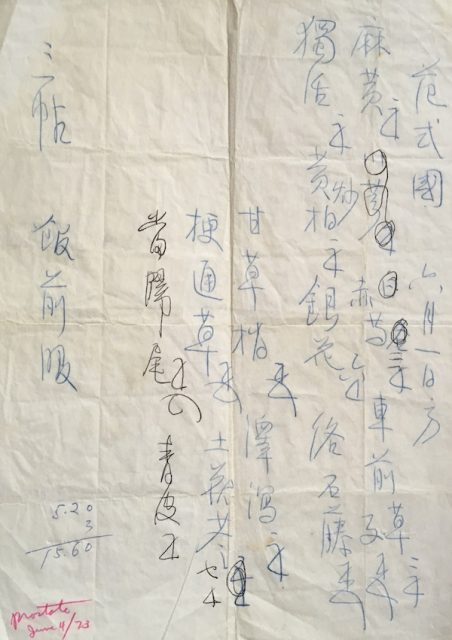
In 1937 the Sino-Japanese war began. Professor Cheng chose from among his special prescriptions those that would be of benefit to the military and gave them to authorities so the government could make the medicine and see to the distribution of them.
Professor Cheng hung out the sign indicating that he was staying at home to wait and treat patients. This was the first time he had done so. His fame as a doctor soon spread far and wide.
From 1928 on, when Wang Ching-wei, Liu Jei-hen, and others, put forward proposals to eliminate Chinese traditional medicine and pharmaceutics, the direct line of the Tao of Chinese medicine drained away day by day until it was almost dry. In contrast to the above were Chiao Yi-fang, Ch’en Kuo-fu, Ch’en Li-fu and others who submitted proposals in favor of Chinese medicine, but the world of Chinese doctors was not able to rise to the occasion. Then, Professor Cheng, together with Dr. Ch’in and other friends of the Tao of medicine founded the National Chinese Medical Association. This association, for the first time In Chinese history, succeeded in uniting all the famous traditional Chinese doctors on the mainland to research the best and finest points of Chinese medicine and pharmacology. As result, Chinese medicine grew and flourished. After the foundation of the association, Professor Cheng was elected its president.
In 1946, Professor Cheng took a position in the National Assembly for the Construction of the Constitution of the Republic of China. The following year he was elected to the National Assembly as the representative of the community of doctors of Chinese medicine.
In 1958, the College of Chinese Medicine and Pharmacology was planned, and Dr. Chin Ch’in, as founder of the school, asked Professor Cheng to be either Director of the Board of Trustees or President of the College. This would add stature to the college. Professor Cheng was polite but firm in his refusal: Sir, you have single handedly done all the work in founding this school, and if I were to take the position of honor, it would not be right.” So he did not accept the offer. However, when the school ran into trouble later on, Professor Cheng stepped forward and spared no effort to help.
Cheng’s life as a martial artist
As a youth Professor Cheng was very weak, so he studied Shaolin Chuan to strengthen his body. At age 27, in Shanghai, suffering from third degree tuberculosis, he studied t’ai-chi ch’uan from the famed master Yang Cheng-fu. In little more than a year Professor Cheng had gained an understanding of the main principles of t’ai-chi ch’uan. During that time, Yang’s wife was stricken with a serious illness. All doctors had been helpless to prescribe for her. But Professor Cheng did not want to see the wife of his teacher die, so he carefully examined her. Eventually, she became well. Mrs. Yang said to her husband, “Now that I am well, how are you going to thank this young man? You must teach him everything you know and don’t hold back a single secret!” Deeply indebted for the favor Professor Cheng had done his family, Master Yang abided by his wife’s request and taught Professor Cheng the important secrets of t’ai-‘chi ch’uan and t’ai chi sword. He held nothing back.
Later, in T’ai-yuan in Shansi Province, Professor Cheng practiced marvelous techniques of tai-chi ch’uan energy with Chang Ch’ing-ling.
After twenty years of constant practice, Professor Cheng condensed the form into 37 postures, thereby making it both easier to teach, to learn, and to practice.
At age 32 he taught t’ai-‘chi ch’uan at the Central Military Academy (formerly the Huang-po Military Academy -equivalent to West Point in the United States).
At the age of 37 he was a consultant to the Hunan Provincial Government. At the same time he also held the post of Director of Martial Arts of Hunan Province. At the time, Hunan consisted of 75 counties. The heads of martial arts in each county came to study with Professor Cheng and went back to their respective counties and taught. It should be noted that Hunan has traditionally been known as a province famous for its martial arts. Professor Cheng had to prove himself a martial arts practitioner worthy of being the provincial head of martial arts.
At the age of 38 he traveled to Chungking in Schezuan province. He took a position with the Central Military Training Group teaching t’ai-chi ch’uan. One time, the British embassy in China gave a banquet. The master of ceremonies asked Professor Cheng to give a t’ai-chi ch’uan demonstration. Some members of the British Army wanted to compete with him. When attacked, Professor Cheng seemed merely to turn over his hand and turn his body slightly and his opponent fell more than ten feet away! Later, at a party given by the American Army, the same thing happened. Onlookers couldn’t help exclaiming their delight and amazement.
At age 48, Professor Cheng moved to Taiwan. There he founded the Stir Jung School of T’ai-chi Ch’uan.
At age 63 he went to America. There he founded the Shr Jung Center for Culture and the Arts (the t’ai-chi school). It was open to all who wanted to study and had a large student body.
At present, those who have directly or indirectly studied Master Cheng’s t’ai-chi ch’uan already number more than 100,000 people. Those who have truly understood his teaching and progressed to the study of the sword number more than 50 people.
Professor Cheng had 5 especially strong points. Furthermore, he could unify them as if they were pearls threaded on a single string. That string was the Tao.
About Cheng’s philosophical work

Because he studied deeply the classics and the sages, he fathomed the depths of the principles of philosophy. Thus the past and the present, the sages of old and this man of the modern world reached a harmony. Therefore in regard to exhausting the possibilities of affairs of all kinds, it was as if he had picked up a coat by the collar. That is to say, he held the reins of control. The venerable Yu You-jen praised him in this way, “He is a unique talent of this era. What others regard as the most difficult of matters, he alone does easily and well. This is not a hollow accolade! The accomplishments of his lifetime were all directed toward developing and expanding traditional Chinese culture. All of the above were products of Professor Cheng’s eclectic nature and penetrating genius, and were original works – not mere compendiums of the works of other scholars. Truly, these writings will weather time and criticism!
[Dec. 1, 1978 with Shr-mu, working on Lao-shr’s biography.] - The original article here showed a photography of Mrs. Cheng, Cheng’s wife, and Tam Gibbs, working on Cheng Man Ching’s biography. (GK)
Cheng’s personality and family
Professor Cheng was a distinguished looking gentleman with a cultured air. His character was outspoken and honest, and he walked a straight path from which he never wavered nor compromised himself.
At age 40, Professor Cheng married Miss Yi-tu, the fourth daughter of Air Marshall Ting, the chief of the brand new Department of Air Force. The young lady was elegant in appearance and quite intelligent. She was a student of medicine and earned her B. A. at Peiking University. She was especially fond of literature and art. Thus she helped her husband educate their children. Everyone knew of her gentle grace.
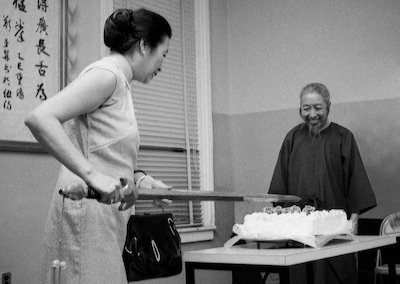
Cheng’s death
Over the past 10 years or so Professor Cheng has traveled in America and Europe, accompanied by his wife. In 1974 he returned to Taiwan to publish Yi Ch’uan (commentary on the Book of Changes) which consisted of more than 100,000 words. He personally proof-read the galleys, and had just gone over them the second time when he said to close friends: “Should I die, I’ll have no regrets.” Everyone took the words as a joke. Who would have thought that at midnight of March 23, 1975 he was found with his head pillowed in his arms on the desk as if asleep. He never woke up. He was immediately sent to the hospital. At 2:15 AM. on March 26, he passed from his world. He was in his 75th year.
Yen Chia-kan, the president of the Republic of China, wrote a memorial for Professor Cheng, “I never dreamed that the first memorial I would write would be that of an old friend.”
Cheng’s literary oeuvre
Among his collections of poetry are: T’ang Shih Chen Tu (commentary explaining the poems of the Tang Dynasty), Yu-ching Ts’ao-t’ang Shih-chi (consisting of two volumes of original poetry by Professor Cheng), Man-ch’ing Tz’u-hsuan (Professor Cheng’s selection of his own tz’u a form of poetry).
Books of his calligraphy and painting include: Cheng Man-ch’ing Hua-chi (an album of Professor Cheng’s paintings), Man-jan Hsieh-yi (a collection of Professor Cheng’s paintings in the hsieh-yi style) Cheng Man-jan Shu-hua Chi (a book of Professor Cheng’s calligraphy and paintings), Man-jan San-lun (Professor Cheng’s writings on poetry, calligraphy, and painting).
In the field of medicine, his books are the following: Nu-k’e Hsing-fa (a publication containing Professor Cheng’s prescriptions and theories about gynecology), T’an-i Pa-yao (about cancer), Ku-k’e Ching-wei (pertaining to orthopedics).
Writings on t’ai chi ch’uan are: Cheng-tzu T’ai-chi Ch’uan Shih-san P’ien (Master Cheng’s 13 Chapters on T’ai-chi Chuan), T’ai-chi Ch’uan (published in English), Cheng-tzu T’ai-chi Ch’uan Tzu hsiu Hsing-fa (Master Cheng’s New Method of T’ai- Ch’uan Self Taught) T’ai-chi (in English, co-authored by Robert W. Smith.)
There is also a movie on t’ai-chi chuan in black and white, and one in color which also shows t’ai-chi sword.
In regard to culture and tradition, he published the following: Lao-tzu Yi-chih Chieh (commentary on the Tao The thing of Lao Tzu), Hsueh-yung Hsing-chieh (a commentary on the Great Learning and the Doctrine of the Mean of Confucius), Jen-wen Ch’ien-shuo (Professor Cheng’s original thoughts on philosophy, culture, and self-cultivation in simplified form), Hsing-pen (Professor Cheng’s treatise concerning the ancient question of whether man is born intrinsically good or, intrinsically bad), Lun-yu Shih-chih (Commentaries on the Analects of Confucius), Yi Ch’uan commentary on the Book of Changes).
The original article here showed a photography of „The altar for paying respects to Professor Cheng. The table was specially set up for the anniversary of his death. The picture is permanent in Professor Cheng’s house.“
Author: Tam Gibbs
Introductory remarks about the text: Gabi Kannenberg
Images: Ken van Sickle and Nils Klug

